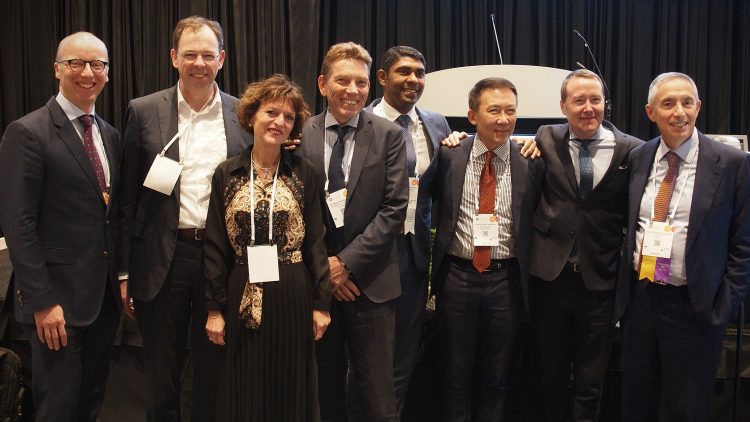AAO 2019
Refractive surgery outcomes, AMD and nutrition, robotics are all hot topics.

Howard Larkin
Published: Friday, November 1, 2019
 Pictured at the ESCRS symposium at AAO 2019: (left to right) Oliver Findl, Rudy Nuijts, Béatrice Cochener-Lamard,
Thomas Kohnen, Marcony R Santhiago, John Chang, George O Waring IV and Paolo Vinciguerra
Drawing on primary research and extensive literature reviews, ESCRS speakers presented long-term refractive surgery outcomes in a special symposium at the AAO 2019 Refractive Surgery Subspecialty Day in San Francisco, USA.
While visual outcomes were generally good for PRK, LASIK and SMILE, Thomas Kohnen MD, PhD, FEBO, of Goethe University, Frankfurt, Germany, noted some issues. These include myopic regression with PRK and LASIK, with LASIK more stable after six years, and challenges predicting and preventing ectasia, and calculating IOL power for subsequent cataract surgery.
Long-term uncorrected vision loss is also an issue with iris-supported and collamer phakic IOLs due to cataract formation and increased axial length, said Rudy MMA Nuijts MD, PhD, of Maastricht University, the Netherlands. Endothelial cell loss runs two-to-three times physiological rates, and 10-year explant rates vary up to 12% for iris-fixated and 18% for ICLs, suggesting patients should be counselled that pIOLs are a temporary solution.
Toric IOL rotation mostly occurs in the first hours after surgery, though fibrosis may result in late rotation, said Oliver Findl MD, of Hanusch Hospital, Vienna, Austria. When implanting toric IOLs in younger patients, future axis shift should be compensated for.
Multifocal IOLs are not advisable for patients at risk of central vision loss, said Béatrice Cochener-Lamard MD, PhD, of the University of Brest, France. Most complications occur in the short term with no reported explantation after 10 years, though 20-year outcomes are unknown, so care should be taken in implanting them in young patients.
Nutrition and AMD
Eating a Mediterranean diet, particularly a lot of fish, may be beneficial for those with early or even intermediate age-related macular degeneration, said Emily Y Chew MD, of the US National Eye Institute, Bethesda, Maryland, USA in the Jackson Memorial Lecture. In the general AMD population studied, a high fish diet reduced progression of AMD by 31%, while high adherence to a Mediterranean diet reduced progression to late AMD by 25-to-40%. “It’s never too late to start.”
Robotic cataract surgery
A fully automated robotic cataract surgery platform guided by intraoperative OCT that extracts the nucleus and cortical materials has been successfully tested in pig eyes and could enter human trials in three-to-four years, said Jean-Pierre Hubschman
MD of the University of California — Los Angeles. Potential advantages include more-complete nucleus and cortex removal and reduced capsule rupture risk due to better visualisation and eliminating tremor in surgeons’ hands. Semi- and fully-automated devices for vitreoretinal surgery are
also in the works.
Pictured at the ESCRS symposium at AAO 2019: (left to right) Oliver Findl, Rudy Nuijts, Béatrice Cochener-Lamard,
Thomas Kohnen, Marcony R Santhiago, John Chang, George O Waring IV and Paolo Vinciguerra
Drawing on primary research and extensive literature reviews, ESCRS speakers presented long-term refractive surgery outcomes in a special symposium at the AAO 2019 Refractive Surgery Subspecialty Day in San Francisco, USA.
While visual outcomes were generally good for PRK, LASIK and SMILE, Thomas Kohnen MD, PhD, FEBO, of Goethe University, Frankfurt, Germany, noted some issues. These include myopic regression with PRK and LASIK, with LASIK more stable after six years, and challenges predicting and preventing ectasia, and calculating IOL power for subsequent cataract surgery.
Long-term uncorrected vision loss is also an issue with iris-supported and collamer phakic IOLs due to cataract formation and increased axial length, said Rudy MMA Nuijts MD, PhD, of Maastricht University, the Netherlands. Endothelial cell loss runs two-to-three times physiological rates, and 10-year explant rates vary up to 12% for iris-fixated and 18% for ICLs, suggesting patients should be counselled that pIOLs are a temporary solution.
Toric IOL rotation mostly occurs in the first hours after surgery, though fibrosis may result in late rotation, said Oliver Findl MD, of Hanusch Hospital, Vienna, Austria. When implanting toric IOLs in younger patients, future axis shift should be compensated for.
Multifocal IOLs are not advisable for patients at risk of central vision loss, said Béatrice Cochener-Lamard MD, PhD, of the University of Brest, France. Most complications occur in the short term with no reported explantation after 10 years, though 20-year outcomes are unknown, so care should be taken in implanting them in young patients.
Nutrition and AMD
Eating a Mediterranean diet, particularly a lot of fish, may be beneficial for those with early or even intermediate age-related macular degeneration, said Emily Y Chew MD, of the US National Eye Institute, Bethesda, Maryland, USA in the Jackson Memorial Lecture. In the general AMD population studied, a high fish diet reduced progression of AMD by 31%, while high adherence to a Mediterranean diet reduced progression to late AMD by 25-to-40%. “It’s never too late to start.”
Robotic cataract surgery
A fully automated robotic cataract surgery platform guided by intraoperative OCT that extracts the nucleus and cortical materials has been successfully tested in pig eyes and could enter human trials in three-to-four years, said Jean-Pierre Hubschman
MD of the University of California — Los Angeles. Potential advantages include more-complete nucleus and cortex removal and reduced capsule rupture risk due to better visualisation and eliminating tremor in surgeons’ hands. Semi- and fully-automated devices for vitreoretinal surgery are
also in the works.